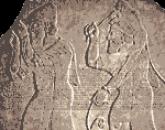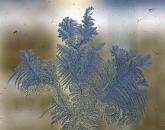Why do birds fly? Penguins and ostriches. flightless birds extinct flightless birds
Not all birds are able to fly - in the course of evolution, some have lost this ability. There are no flying species in the penguin order. In other groups, there are both flying and flightless ones, such as cormorants and parrots. Flightless birds are usually found on islands where there were no predators at one time. However, these days they can fall prey to dogs, mongooses and other predators. Very large birds, such as ostriches, also do not fly, but they run fast and defend themselves with strong legs.
How birds hover in the air
Usually, when a bird flaps its wings, it is moving forward. But some species, such as ospreys, sunbirds and kingfishers, can hang in the air.
Amazing in this respect are tiny hummingbirds that hover in front of a flower to drink nectar. At the same time, the bird, as it were, stands on its tail, and the wings quickly describe the eight in a horizontal plane. Hummingbirds are able to flap their wings for a very long time and with great frequency due to the fact that their pectoral muscles are huge in relation to body size.
When a bird flies forward, thrust is created only by lowering the wing, and lift is created by lowering and flapping. In other birds, lift occurs only when the wing moves down. When a hummingbird hovers, the torso and wings assume an almost vertical position, while the wings create lift, but not thrust.
Why do eagles soar?
Almost all birds soar from time to time, at least for a short time. Even hummingbirds can interrupt their buzzing flight to glide from flower to flower on fixed wings.
Birds as heavy as swans and bustards hover only when they land. Small birds, as a rule, cannot effectively glide through the air for any length of time. For many birds, soaring is not only an alternative to conventional flapping flight. Some species of hawks, as well as eagles, pelicans and storks, fly mainly by soaring - gliding upwards through the air. Having long wings compared to the body, these birds use ascending air currents (if the air is still, it is impossible to fly like that).
Updrafts exist near obstacles: in mountains, over hills, cliffs, etc. - here they are small, local. In addition, vast air masses rise when the reflected heat of the sun warms the air near the earth's surface. In such a flow, upward movement occurs in a wide spiral, while the rising air mass forms, as it were, a large dome. Thermal updraughts are usually absent over large bodies of water, and also at night. With few exceptions, soaring birds avoid places where sea meets land and do not fly in the dark.
In an updraft, the bird rises in circles to a great height, moves in the desired direction horizontally in the process of a smooth descent, reaches the next stream and rises again in circles. In this way, birds manage to cover a long distance in one day, eventually covering thousands of kilometers.
Birds of prey are excellent fliers. Among them are real aerial acrobats, such as the field harrier, which passes food to its partner in flight. The male and female differ in color, but both have a white tail.
The male throws the prey to the female, who turns upside down to catch it.
Why do seabirds fly so well?
The ascending air currents that provide birds soaring over land are absent over the sea. Therefore, birds such as albatrosses, petrels and boobies use a fundamentally different soaring technique.
Seabirds have a special gliding flight, using the power of horizontal winds and air jets reflected from the waves. Air currents near the surface of the water are slower than at altitude. The bird glides from a height almost to the water itself, then, due to the acceleration from the descent, soars up and turns sharply against the wind. The wind creates lift, carrying the bird up into a band of more powerful air currents. Finally she turns around and glides down again.
Takeoff and landing of birds
For many birds, takeoff and landing is the most difficult maneuver. When taking off, the bird needs to be given a strong acceleration in order to get off the ground or a branch. For example, a small sparrow jumps up before taking off and begins to rapidly flap its wings. Heavier birds, in order to take off, take a run with spread wings. Waterfowl run across the water to gain speed before taking off.
The masters of the air, swifts and frigates, are not able to take off from the ground; for take-off, these birds fall from a height with their wings spread.
When landing, birds glide using their wings. During landing, their body turns vertically, the bird spreads its tail, and lowers its legs down, putting it forward. The role of the brake when landing in birds is performed by the wing, this is a bunch of feathers on the first finger of the wing.
To land, the bird needs to transform the forward movement and soften the impact on the ground. If the movement does not slow down enough, or if a gust of wind interferes, the bird may break.
When landing, the duck flies low over the water and splashes down, braking with its webbed feet and creating a reverse stroke with its wings to reduce speed. To take off from water or land, the bird creates a stream of air with its wings. So, the dive runs through the water, flapping its wings until it gains enough speed to break away from the surface.
Swallows in flight
Swallows in a graceful and long flight catch insects, touch the water in flight to drink. Here is a killer whale, common in Europe, North America, Asia and Africa. These birds rarely come down to the ground, mainly for nest material. This is done by males, whose tail is longer and the fork on it is deeper than that of females, whose task is to build a nest.
Swallows have very long seasonal flights: killer whales fly from Norway to South Africa, covering 11,000 km.
When chasing flying insects, swallows change the direction of flight almost all the time. Swallows on the fly not only eat, but also drink, opening their beaks very wide.
Birds that can't fly are just as strange as animals that can't walk or fish that can't swim. Why, then, do these creatures need wings if they cannot lift them into the air? Nevertheless, on our planet there are whole detachments of such creatures. Some live in the sultry African savannah, others live on the icy Antarctic shores, and still others live on the islands of New Zealand.
Foreword
If we compare all types of birds that exist on our planet, then flightless birds occupy an insignificant part compared to flyers. Why is that? The thing is that the ability to fly helps them survive in the wild. Wings not only save birds from but also make it possible to get their own food. So, in search of food, birds are able to travel great distances, and this is much more convenient than scouring the ground in search of food. In addition, flyers can build their nests to raise their offspring at a considerable height, so that a dangerous enemy cannot reach the chicks. It turns out that it is much easier for birds that can fly to survive in a cruel world called "wildlife". This ability helped them become the second largest class of vertebrates. So, for example, scientists have 8,500 different species of birds, but there are only 4,000 species of mammals. If flying is such an important way for birds to survive, then why don't some of them have this skill? How did flightless birds adapt to survive? We will analyze examples below. Scientists believe that earlier these birds also knew how to fly, but in the course of evolution they lost this ability. Well, let's look at what such strange creatures are.

Flightless birds: list

Flightless Birds: Penguins
These creatures are excellent swimmers and divers. They are found only in the southern hemisphere of our planet. Most of them live in Antarctica, but some species can survive in temperate and even tropical climates. Some representatives of penguins spend up to 75% of their lives in water. These flightless birds can stay underwater thanks to their heavy, hard bones, which act as ballast, much like a heavy belt for a diver. Penguin wings have evolved into fins. They help control movement in the aquatic environment at speeds up to 15 miles per hour. These birds have a streamlined body, paddle-shaped legs, an insulating layer of fat, and waterproof feathers. All these properties allow the penguin to feel comfortable even in icy water. To keep warm, they have very stiff and very densely spaced feathers that provide waterproofing. Another property that allows survival in the wild is the unique white and black coloring of the birds in question. It makes the penguin invisible to predators both from below and from above. These birds live in colonies reaching the number of several thousand individuals. Penguins are the most numerous representatives of "non-flyers". So, annually up to 24 million of these creatures visit the coast of Antarctica.

ostriches
African ostriches are the largest birds on our planet. Their height can reach 2.7 meters, and weight - 160 kg. These flightless birds feed on grass, tree shoots and shrubs, do not disdain insects and small vertebrates. In nature, the creatures in question live in small groups - one male and several females. Ostriches have very sharp eyesight and excellent hearing. They are excellent runners. In case of danger, an ostrich can reach speeds of up to 70 km / h. In addition, he is an excellent fighter, his two-toed paws are a serious weapon. Judge for yourself: for one centimeter of the body with this bird, there is a force of 50 kg. In addition to high speed and excellent fighting qualities, the ostrich is distinguished by the ability to disguise itself well. In case of danger, it lies down and presses its neck and head to the ground, as a result it is difficult to distinguish it from an ordinary bush. As you can see, this representative of the “non-flyers” has perfectly adapted to survive in the wild.
Nandu-shaped
These flightless birds are common in South America: Argentina, Brazil, Bolivia, Uruguay and Paraguay. They inhabit the pampas (open spaces, steppes), covered with herbs and shrubs. An adult individual reaches a length of 140 cm, its weight is 20-25 kg. In appearance and lifestyle, the nandu resembles an ostrich, but scientists believe that these are completely different species. In nature, these birds live in groups of up to 30 individuals. In case of danger, an adult rhea can reach speeds of up to 60 km / h. Among natural predators capable of preying on adults are jaguars and cougars. But the young are suffering from the attacks of wild dogs. In addition, armadillos love to destroy the nests of these birds.
cassowaries
These flightless birds have much in common with ostriches, but their main difference is their three-toed paw. They are found in Australia and New Guinea. There are only two families in this detachment: Emu and Cassowaries. The latter reach 170 cm in length, their weight is 80 kg. They are characterized by a laterally compressed beak and a horn-like "helmet" on the head. Unlike ostriches and nandu, cassowaries prefer to live in forest thickets. They feed on fallen trees and small animals. Otherwise, the representatives of this detachment are similar to their close relatives - ostriches.

kiwifruit
Representatives of this species are nocturnal, live in the dense forests of New Zealand. During the day, kiwis hide in bushes and dense thickets of the forest, and at night they wander in search of food, which they find thanks to their well-developed sense of smell. They feed on worms and other invertebrates, which are pulled out of the damp soil. With the help of a long beak, these birds not only get food, but also make small depressions in the forest floor, in which they hide themselves.
Tristan Shepherd
It is the smallest flightless bird on earth. Now this species is preserved only on the island of Inaccessible (it is free from people and predators) of the Tristan da Cunha archipelago. Previously, these birds were found in abundance on all nearby islands, but the cats brought by the white man completely destroyed this species on them. Shepherd prefers open meadows and fern thickets. It feeds on moths, earthworms, seeds and berries.
kakapo parrot
This bird is listed in the Red Book. She cannot fly, but she can glide from high ground to the ground. Despite the presence of full-fledged wings, the kakapo has weak muscles and heavy bones without air cavities. The bird is nocturnal and feeds on fern leaves, mosses, berries and mushrooms.
Extinct flightless birds
The most famous extinct "non-flyers" today are the wingless auk, and the first of them belonged to the Chistikov family. The length of her body was 70 cm. The wings were quite small, but well adapted for rowing under water. The bird was completely exterminated in the 19th century. Dodo, or Mauritian dodo, is an extinct flightless bird that inhabited the Mauritius islands in the Indian Ocean. It was completely exterminated by a white man and imported cats during the expansion of these lands.

Conclusion
So we looked at how flightless birds adapted to survive in the wild. The list of them, as you can see, is, in principle, quite diverse. Scientists believe that the first "non-flyers" appeared on the islands due to the fact that the food supply there was abundant, and there were no predators at all. Probably, this is precisely what explains the fact that individuals with both developed and underdeveloped wings, or even without them, survived equally under the mentioned conditions.
Target: To acquaint students with the reasons for the diversity of birds.
Tasks:
- students should learn to recognize the ecological groups of birds,
- know the reasons for the diversity of birds,
- know the signs of birds of different ecological groups,
- be able to find information from different sources,
- be able to summarize the information received and draw conclusions
- be able to work in groups.
Equipment:
- stuffed animals or drawings of birds of different ecological groups,
- electronic laboratory work (Laboratory workshop. Biology grades 6-11. Educational electronic edition.)
Lesson plan.
- Organizing time.
- Repetition of previous material.
- Formulation of the problem.
- Performing laboratory work.
- Conclusion.
During the classes
1. Organizational moment.
2. Repetition of the previous material.
The sparrows fluttered onto the fence.
The cat hears the sparrow choir
Only she can’t get sparrows:
I was too lazy to learn how to fly!
V. Bezborodov
List the signs of the class of birds (as a result of a frontal survey, students should name the signs, write them down on the board)
- Body covered with feathers
- Forelimbs modified into wings
- Beak without teeth
- fast digestion
- Lightweight skeleton (bone cavities)
- warm-bloodedness
- Special breathing (air sacs)
- There is a keel
Conclusion: thanks to these adaptations, birds are able to fly.
Do all birds fly the same way?
(messages prepared by students):
- flapping flight
- Gliding flight
- shaving flight
Reasons for this diversity?
(Living in different conditions, adaptation to them.)
Are there flightless birds? (most often students say:
- Ostrich
- Penguin)
By what signs can we determine the ability of a bird to fly?
- Wings (shape, size)
- Plumage (dense, loose)
- The size and weight of the bird
3. Statement of the problem:
Do flightless birds fly?
If you study the signs of a bird, you can determine its ability to fly.
4. Performing laboratory work "Ecological groups of birds".
Based on the results of laboratory work, a table is filled in (work in groups):
| Environmental group | Representatives | signs | ||
| Description of the wings | Weight and body size | Description of plumage | ||
| Ground | Ostrich, bustard, little bustard, guinea fowl | Wings are not developed, without flight feathers, | Birds of medium or large size | The feather cover is loose. |
| marsh | Heron, stork, bittern | Well developed, large, wide. | Small, medium, large. | The feather cover is loose, a small amount of down feathers. |
| Waterfowl | Eider, swan, cormorant, great grebe, penguin, mallard, goose | Well developed. | Medium and large, but smaller than ground ones. | Penguins have small feathers. There are no down feathers. All feathers are hard, dense, lean on each other. Can lubricate with secretions of the coccygeal gland. |
| Air-water | Seagull, tern, petrel | Well developed, relatively large | small and medium | dense hard |
| Air-ground | Swift, swallow, nightjar | Relatively large and narrow. | small | dense soft |
| birds of the forest | Woodpecker, owl, capercaillie | Broad, well developed | Medium and small | Diverse (hard, soft, in owls - loose) |
The ostrich is a land bird that is unable to fly.
The penguin belongs to aquatic birds, by all indications adapted to flight.
5. CONCLUSION: the penguin is able to “fly”, but in the aquatic environment.
6. Homework: reports of bird orders.
Working on the project "Secrets of birds", we decided to find out if all birds fly and why some of the representatives of birds have lost the ability to fly. After watching this presentation, you can get acquainted with flightless birds and find out why they cannot fly.
Download:
Preview:
To use the preview of presentations, create a Google account (account) and sign in: https://accounts.google.com
Slides captions:
Project: “Do all birds fly? Why can't some birds fly? Head: primary school teacher MBOU - Poluzhskaya school Pinchukova Elena Fedorovna. Performers: 3rd grade students
Flightless birds do not have a keel, an outgrowth on the sternum to which powerful muscles are attached that are responsible for flight. All flightless birds have either a very small keel or none at all. For this reason, their wings are weak, and the birds are not capable of flight.
Ostriches are the largest birds living on Earth today. Some of them reach a height of 2.7 meters. Ostriches live in the open plains of Africa. Ostriches feed on seeds, fruits, as well as lizards and insects. Ostriches cannot fly, but they can run fast. At short distances, they can reach speeds of up to 70 km / h.
Emus are large flightless birds living in Australia, they reach a height of 2 m. These birds feed on seeds, fruits and insects.
So why don't ostriches fly? And here's why! They are too big, a bird can fly if its mass does not exceed 20 kg, and ostriches weigh 120 kg.
It is interesting! One ostrich egg is equal to 40 chicken eggs and can support the weight of a person.
Penguins are flightless birds. There are 18 different types of penguins. They live only on the coasts of the seas of the Southern Hemisphere - on islands off the coast of Australia, in New Zealand, in South Africa and in southern South America. Penguins are excellent swimmers, they can move through the water at a speed of 30 km/h. Those penguins that live among the snow and ice do not make nests.
The emperor penguin is the largest of the penguins. His height is about 1.2 meters, and his weight is about 75 kg. When the female lays an egg, the male protects it from contact with ice by placing it on his own webbed feet. When the chick hatches, the male, having eaten nothing for two months of incubation, goes in search of food, while the female stays with the chick to feed and protect him.
The jumping penguin is named so due to the fact that it jumps very dexterously from stone to stone. Its most noticeable difference is a long crest on its head. Newly hatched jumping penguin chicks are covered in soft down. They are helpless, and parents have to feed and protect them for several weeks.
The donkey penguin makes a sound similar to the cry of a donkey. It is also known as the black-footed penguin.
King penguins live in Antarctica. They can slide on their belly on ice at high speed to get away from enemies.
Why don't penguins fly? Penguins used to fly, but more often hiding from enemies, hiding under water, and gradually their wings lost their feathers and turned into fins.
But that's not all that these birds can surprise us with. We eat three times a day, and penguins may not eat for up to three months. A person cannot live without air, and penguins can not breathe for almost 18 minutes. How interesting!
Kakapo, or owl parrot, is the only parrot that has forgotten how to fly. He lives only in New Zealand, he had no enemies around him and he did not need to hide or fly away. Kakapo lives in burrows. He spends the whole day in them and only after sunset he leaves from there to go in search of food - plants, seeds and berries.
The little Kiwi bird also lives in New Zealand and is protected by the state. She has no wings at all.
Kiwi is a small and shy nocturnal bird. The kiwi has an excellent sense of smell, and the nostrils are located at the end of its long beak. Kiwis stick their beaks into the ground to find food.
The Tristan shepherd, living on the island of Unapproachable, is the smallest flightless bird in the world. It is only 17 cm long and weighs less than 30 g.
So, let's conclude: there are flightless birds on earth. But why don't they fly? 1. Have a large size and body weight. 2. Due to predators, birds swam more than they flew. 3. There were no predators and there was no need for birds to fly.
On the topic: methodological developments, presentations and notes
Lesson Type: General Educational Objectives: Expand your understanding of wintering birds. Form the concept of wintering birds. Clarify and activate the vocabulary on the topic, learn to answer the question ...
To an extracurricular activity for the Day of Birds. "Miracle Birds"
This presentation was made for Birds Day. It can be applied in the lessons of the world around us in elementary school ....
Popular
- How to make a flyer that won't get thrown out?
- Let's move on to the process.
- Why do we need packages for car wheels How is the production of branded packages with a logo
- The history of TCL and its smartphones Alcatel
- Why do birds fly? Penguins and ostriches. flightless birds extinct flightless birds
- Why do balloons fly?
- The development of the economy and economic thought of European civilization during the Middle Ages (V-XV centuries
- Distributed Wi-Fi from a laptop, but the Internet does not work "Without access to the Internet
- Why distribution of wifi without access to the Internet
- Water delivery business plan Water delivery business plan 19 liters





